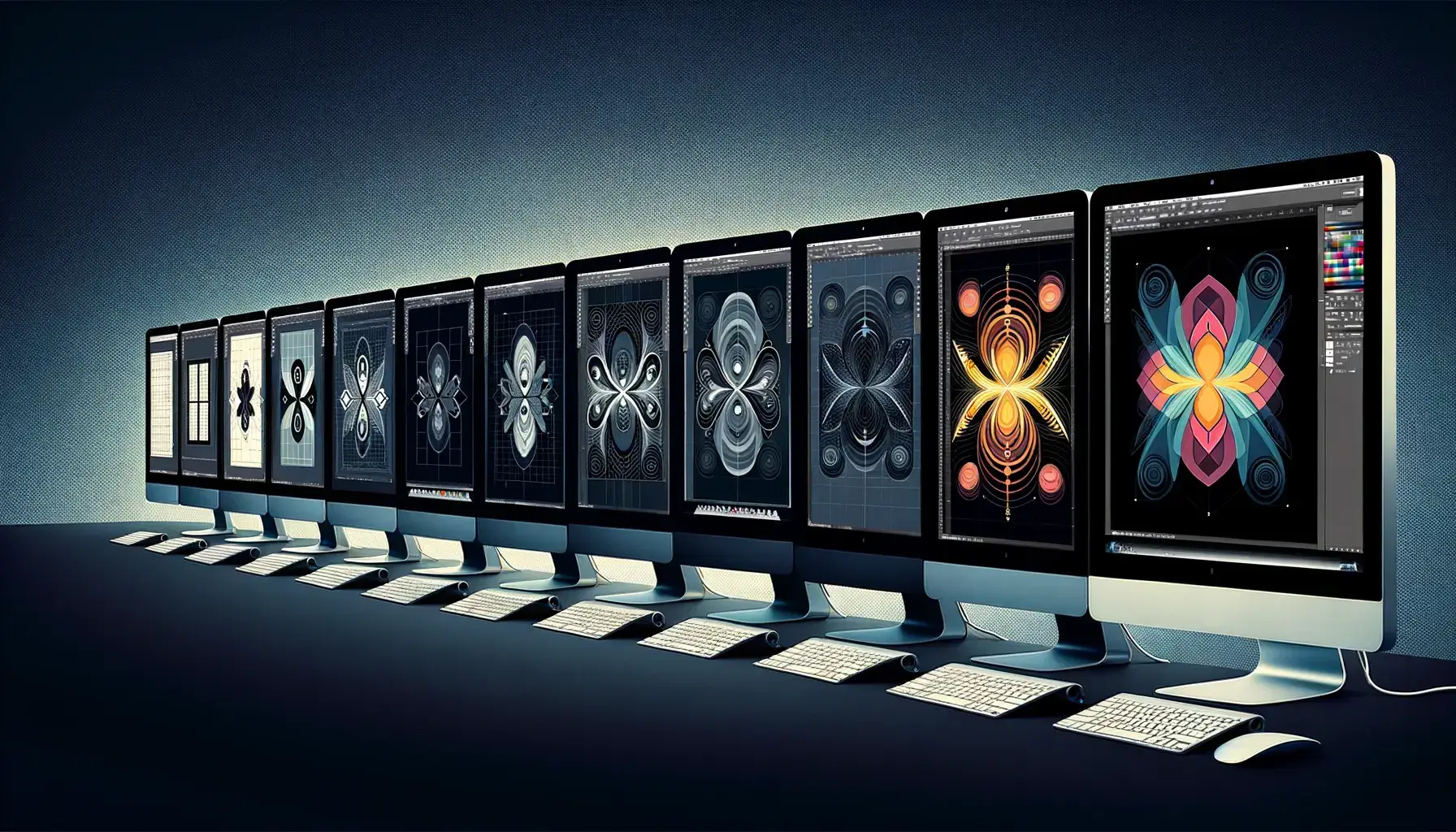The Evolution of Adobe Illustrator: A Journey Through Time – Exploring adobe illustrator history and its impact
Adobe Illustrator’s influence extends beyond mere functionality; it shapes the very culture of design. The community of users has grown exponentially, creating a vast ecosystem of tutorials, plugins, and extensions that enhance the software’s capabilities. This emphasis on user engagement and community-driven development has played a crucial role in Illustrator’s evolution, fostering a collaborative spirit that continues to this day.
As we examine the adobe illustrator history, we can observe how it has been instrumental in shaping design practices.
The adobe illustrator history reveals a timeline of innovation and creativity that continues to inspire designers worldwide.
Understanding the adobe illustrator history helps us appreciate its impact on the design world and its continuous growth.
Moreover, the accessibility of Adobe Illustrator through subscription models has democratized design tools, allowing freelancers and small businesses to access professional-grade software without the hefty upfront costs that were once a barrier. This shift has enabled a new generation of designers to innovate and experiment without fear of financial constraints.
Illustrator 88 served not only as a design tool but also as a catalyst for the digital arts movement during the late 1980s. It sparked a wave of creativity among artists who embraced the new medium of digital art. For instance, designers began creating intricate logos and illustrations for print media, helping brands establish a distinctive visual identity that set them apart in a burgeoning marketplace.
Adobe Illustrator, a cornerstone in the graphic design industry, has come a long way since its inception. As a vector graphics editor, Illustrator has been pivotal in shaping the world of digital design, offering precision and flexibility unmatched by pixel-based counterparts. This article delves into the rich adobe illustrator history, mapping its growth from a simple drawing program to a powerhouse of design. Understanding the adobe illustrator history is essential for any designer.
The Beginnings: Illustrator 88
Throughout its journey, Adobe Illustrator has often mirrored the technological advancements of the time. The introduction of layers in Illustrator 3 was a response to the growing complexity of design projects, allowing for more organized workflows. Designers began to employ layers to separate elements, enabling greater flexibility and control over their designs. This shift towards a more structured approach to design helped professionals manage increasingly intricate projects.
With Illustrator 5, the support for spot colors revolutionized printing processes. Designers could now produce vibrant, accurate colors that were previously difficult to achieve. This capability was particularly pivotal for print advertisements and branding materials, where color consistency is crucial. The ability to separate colors for printing opened doors for designers to produce more visually stunning outputs, significantly elevating the quality of printed materials.
As we delve deeper into the present features of Adobe Illustrator, it’s essential to highlight how the software continuously adapts to the changing landscape of design. The integration of AI tools not only enhances creative possibilities but also streamlines workflows, allowing designers to focus more on innovation and less on repetitive tasks. For example, the Puppet Warp tool empowers users to manipulate designs intuitively, leading to more expressive and dynamic illustrations.
In light of the adobe illustrator history, we see how collaboration has evolved alongside technological advancements.
As we explore the adobe illustrator history, it is evident that educational resources play a significant role in its widespread use.
Reflecting on the adobe illustrator history helps us appreciate the supportive community that surrounds this software.
Launched in 1987 for the Apple Macintosh, Adobe Illustrator began its journey as a revolutionary tool for designers and artists. Named “Illustrator 88” in reference to its release year, it introduced the concept of vector graphics to a broader audience. The ability to create designs that could be scaled infinitely without loss of quality was a game-changer. This first version laid the foundation for what would become the industry standard in vector graphics editing.
Additionally, the introduction of cloud documents signifies a monumental shift in how designers collaborate. This feature allows multiple users to work on the same project in real-time, breaking down geographical barriers and fostering a global design community. This collaborative model is particularly beneficial in today’s fast-paced environment where teams often span across different time zones.
The updates in Adobe Illustrator reflect its long and rich adobe illustrator history, showcasing its adaptability.
Understanding the adobe illustrator history allows us to predict future developments and trends.
The commitment to enhancing Adobe Illustrator’s features is rooted in its extensive adobe illustrator history.
Moreover, the educational aspect of Adobe Illustrator cannot be overlooked. Numerous online platforms provide comprehensive courses that teach users everything from the basics to advanced techniques. This accessibility encourages not only new users but also seasoned professionals to enhance their skills continuously, adapting to the software’s ongoing updates and innovations.
The ongoing evolution of Adobe Illustrator is a continuation of its impressive adobe illustrator history.
As we reflect on the adobe illustrator history, it becomes clear that the software’s impact extends beyond technical achievements. It has fostered a creative culture where ideas can flourish. The community’s support through forums, social media, and conferences creates an environment rich in collaboration and inspiration. As designers share their projects and techniques, they not only contribute to their growth but also to the overall advancement of the design field.
Evolution Through the Years
Adobe Illustrator’s evolution is marked by significant updates, each bringing new features and improvements that have kept it at the forefront of design technology. Let’s explore the major milestones in its development through a detailed table.
| Release Date | Version | Main Features of the Update |
|---|---|---|
| 1987 | Illustrator 88 | Introduction of vector graphics editing. |
| 1990 | Illustrator 3 | Layers, making the management of complex designs easier. |
| 1993 | Illustrator 5 | Introduction of color separations, spot color support, and the Pathfinder operations. |
| 1997 | Illustrator 7 | A revamped user interface, similar to Adobe Photoshop, and introduction of pathfinder tool. |
| 2003 | Illustrator CS | Integration into the Adobe Creative Suite and introduction of 3D effects. |
| 2007 | Illustrator CS3 | Live Color, allowing users to change colors in complex designs more easily. |
| 2010 | Illustrator CS5 | Perspective Drawing, making the creation of complex geometries simpler. |
| 2012 | Illustrator CS6 | A new performance system called Mercury Performance System for faster processing. |
| 2015 | Illustrator CC | The switch to a subscription model with Creative Cloud and enhancements to the UI. |
| 2018 | Illustrator CC | Properties panel, Puppet Warp tool for more flexible illustrations. |
| 2020 | Illustrator 2020 | Introduction of cloud documents, enhanced glyph snapping, and background save. |
| 2023 | Illustrator 2023 | Advanced AI features, improved 3D effects, and real-time collaboration tools. |
| 2024 | Illustrator 2024 | improved alignment, 3D vector art creation, refined controls, and better text management. |
The Present and Future
The most recent versions of Adobe Illustrator underscore Adobe’s commitment to innovation, with features like real-time collaboration and enhanced 3D effects powered by AI. As we look toward the future, it’s clear that Adobe Illustrator will continue to evolve, embracing new technologies to remain an indispensable tool for designers around the globe.
There are now versions of Illustrator for the iPad and web. The table above refers to the Windows and MacOS versions of the Desktop product.
Conclusion
From its modest beginnings to its current status as a behemoth in the design world, Adobe Illustrator’s journey is a testament to Adobe’s vision and commitment to the creative community. With each update, Illustrator has pushed the boundaries of what’s possible in graphic design, enabling artists and designers to bring their most ambitious ideas to life. As technology advances, we can only anticipate what future versions of Adobe Illustrator will bring to the creative table, further enriching the adobe illustrator history.



